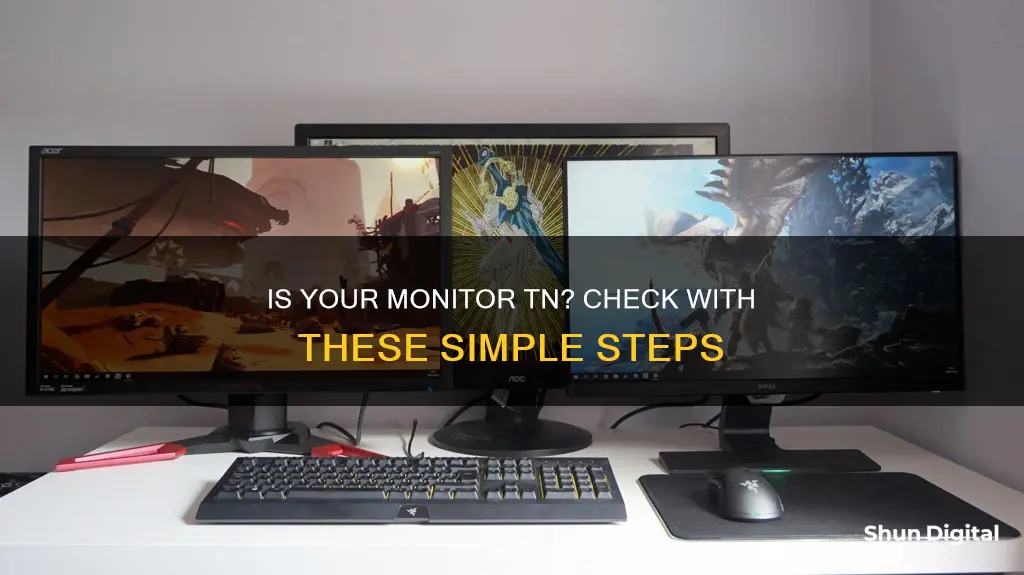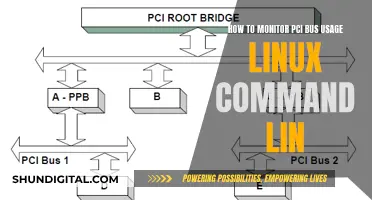
TN, or Twisted Nematic panels, use a nematic liquid crystal to rotate and pass light through, corresponding to the signal transmitted. TN panels are known for their speed and affordability, making them a popular choice for gamers and general consumers. However, they may not be ideal for colour-sensitive work as they lack 100% accurate colour reproduction. To identify a TN panel, you can check if the image and colour quality remain stable when viewed from extreme angles. If the viewing angles are poor and the colours wash out, it is likely a TN panel.
| Characteristics | Values |
|---|---|
| Response Time | Faster than IPS panels |
| Price | Cheaper than IPS panels |
| Refresh Rate | Can go as high as 144Hz |
| Colour Reproduction | Lacks 100% accurate colour reproduction |
| Viewing Angle | Can discolour if viewed from a relatively extreme angle |
What You'll Learn

TN panels have faster response times than IPS monitors
TN panels are known for their fast response times, which make them a popular choice for gamers, especially those engaged in competitive gaming. The response time of a monitor is the time it takes for a pixel to change from one colour to another, and it is measured in milliseconds (ms). TN panels typically offer lower response times, often around 1ms, while IPS panels usually have response times of about 4ms. This difference can be crucial for gamers, where every millisecond counts.
In addition to faster response times, TN panels also offer higher refresh rates, typically 144Hz, compared to 60Hz for IPS panels. Refresh rate refers to the number of times the screen updates with new information per second, and it is measured in Hertz (Hz). A higher refresh rate results in smoother and more fluid visuals, which is beneficial for fast-paced gaming or high-definition video playback.
While TN panels excel in speed, they tend to fall short in terms of colour accuracy and viewing angles. They are only capable of displaying 262,144 colours, which can result in colour banding and a less immersive visual experience. Additionally, the colours on TN panels may appear distorted when viewed from different angles, which can be a drawback for those who share their screen with others or use their device in various positions.
On the other hand, IPS panels provide superior colour accuracy and wider viewing angles. They can display 16.7 million colours, ensuring smooth gradients and accurate colour reproduction. The wide viewing angles of IPS panels mean that the colours and contrast remain consistent even when viewed from side angles, making them ideal for collaborative work or for users who like to adjust their screen position.
In summary, TN panels offer faster response times and higher refresh rates, making them a popular choice for gamers seeking a competitive edge. However, IPS panels provide superior colour accuracy and wider viewing angles, resulting in a more visually appealing and consistent display. The decision between TN and IPS panels ultimately depends on the specific needs and preferences of the user.
Choosing the Right Wide Monitor: Measure for Best Experience
You may want to see also

TN monitors are generally cheaper than IPS
TN panels, or Twisted Nematic panels, are the most common type of PC monitor. They are also the cheapest option on the market. TN monitors are ideal for gamers or those on a budget. They are the fastest option, with a 1ms response time, and have low input lag. This is why they are often used in a competitive gaming environment. TN monitors can also offer high resolutions of up to 4K and have an impressive refresh rate of up to 240Hz.
However, TN panels do have their drawbacks. The viewing angles and colour accuracy are not as good as those of IPS panels. If you are looking for a monitor with accurate colours, then a TN panel may not be for you. The colours can appear washed out, and the viewing angles are limited. This means that if you are not sitting straight on, the picture quality will be affected.
IPS panels, or In Plane Switching panels, are another type of display technology commonly seen on smartphones. They offer a much better viewing experience, with richer colours and wider viewing angles. This makes them a good choice for creatives or anyone who wants their photos and videos to really stand out. IPS panels also have the benefit of generally looking better. However, they are typically more expensive than TN panels and have a slower response time, usually starting at 4ms.
So, if you are looking for a budget-friendly option and don't require perfect colour accuracy, a TN monitor is a great choice. But if you are willing to pay more for better colours and viewing angles, then an IPS monitor may be a better investment.
Returning an ASUS Monitor to Amazon: A Step-by-Step Guide
You may want to see also

TN panels have worse colour accuracy than IPS
TN panels have significantly worse colour accuracy than IPS panels. TN panels are only capable of displaying 262,144 colours, while IPS panels can display 16.7 million colours, which is the maximum number of colours that can be produced by graphics cards. This results in colour banding in TN panels, where distinct bands of colour can be seen instead of a smooth gradient.
The colour accuracy of a display panel is a measurement of how well it displays a specific colour when instructed to by the graphics card. TN panels struggle with colour accuracy, and the colours may appear distorted when viewed from different angles. This can be a major drawback for people who often share their screen with others or for those who like to watch movies or play games from different positions.
IPS panels, on the other hand, are renowned for their superior colour accuracy and consistency. They offer a more consistent and accurate colour display, regardless of the angle you're viewing the screen from. This makes them an excellent choice for professionals who require accurate colour representation, such as graphic designers and photographers.
In terms of bit depth, true 10-bit or 12-bit panels tend to be IPS-only. Most TN panels are either 6-bit with FRC (temporal dithering) or 8-bit. A monitor with FRC simulates a higher bit depth by quickly flicking a pixel between a high and low value. This can sometimes be seen as a grainy overlay or faint static, but it is usually not noticeable from a distance.
The gamut of a monitor describes the range of colours it can display. While technically there's no reason a wide-gamut backlight can't be used with TN, the cheaper nature of TN screens tends to preclude it. Many IPS displays have sRGB backlights, but monitors with expanded gamuts tend to be IPS-only. If you require a wide-gamut display, then TN-based ones practically don't exist, and IPS is the only real option.
Overall, a good-quality TN display can be hard to tell from an IPS display when looking head-on at typical web-type content. However, when it comes to colour accuracy, TN panels fall short compared to IPS panels.
Opening a ViewSonic LCD Monitor: Step-by-Step Guide
You may want to see also

TN panels are popular with gamers
TN panels are a popular choice for gamers and professionals alike. TN stands for Twisted Nematic, a type of LCD panel and a form of LED panel. They are known for their fast response times, low input lag, and accurate colour reproduction.
One of the biggest advantages of TN panels is their fast response times, which can be as low as 1ms. This makes them ideal for gaming, as they can keep up with fast-moving images without any noticeable lag, resulting in a smoother and more immersive experience. TN panels are also a popular choice for fast-paced professional applications such as video editing and graphic design.
Another advantage of TN panels is their low input lag, which is the delay between a command and when it appears on the screen. With TN panels, this lag is usually very low, giving gamers a competitive edge and improving productivity for professionals.
While TN panels were once known for poor colour reproduction, modern TN panels have improved significantly and now offer accurate colour reproduction. This makes them a good choice for professionals who require colour accuracy, such as photographers and designers.
TN panels are also often more affordable than other panel types, making them a budget-friendly option for those seeking high-performance displays. With their fast response times, low input lag, and accurate colour reproduction, TN panels are a reliable and affordable option for gamers and professionals alike.
Asus Monitor Product Key: Where to Find It?
You may want to see also

TN panels are worse than IPS when viewed at an angle
Twisted Nematic (TN) panels and In-Plane Switching (IPS) panels are two of the most common types of display panels, each with its unique strengths and weaknesses. When it comes to viewing angles, TN panels are indeed worse than IPS panels. This is because TN panels have limited viewing angles, particularly on the vertical axis, while IPS panels offer wide viewing angles.
The viewing angle of a display panel refers to the range of angles from which the screen can be viewed without any significant loss of image quality. TN panels often have narrow viewing angles, which means that the colours and contrast can shift dramatically when viewed from angles other than straight ahead. This can be a major drawback for people who often share their screens with others or for those who like to watch movies or play games from different positions. In some cases, the colours on a TN panel may even invert completely when viewed from extreme angles.
On the other hand, IPS panels provide consistent and accurate colour display and superior colour accuracy, regardless of the viewing angle. This means that the colours and images remain consistent even when viewed from side angles or from extreme angles. IPS panels can display up to 16.7 million colours, which is the maximum number of colours that can be produced by graphics cards. This makes them an excellent choice for professionals who require accurate colour representation, such as graphic designers and photographers.
The difference in viewing angles between TN and IPS panels is due to the way the liquid crystal molecules are aligned within the panels. In TN panels, the molecules are twisted, which causes light to scatter when passing through, resulting in narrower viewing angles. IPS panels, on the other hand, use a different type of alignment that allows light to pass through with less scattering, resulting in wider viewing angles.
In summary, TN panels have narrower viewing angles compared to IPS panels, which can result in distorted colours and contrast when viewed from angles other than straight ahead. IPS panels, with their wider viewing angles, provide consistent and accurate colour display from any angle, making them a better choice for professionals who require accurate colour representation.
Monitoring Bandwidth Usage: Android Tips and Tricks
You may want to see also
Frequently asked questions
If the viewing angles are bad, then it's likely a TN monitor. You can also check by looking at your monitor screen from extreme angles, left to right, and top to bottom. If the image and colour quality stay relatively stable, then it's an IPS monitor.
TN, or Twisted Nematic panels, use a ‘nematic’ kind of liquid crystal to rotate and pass light through, corresponding to the signal transmitted. The main advantage of TN panels is speed, and they are generally cheaper than IPS monitors. However, they lack 100% accurate colour reproduction. IPS, or In-plane Switching, monitors are generally preferred by professionals as they more accurately portray colours of images, and have excellent viewing angles.
TN panels have a better response time and are more affordable. If you're just sitting in one place in front of your computer and absolute perfect colour reproduction isn't important, then TN is a good choice.







